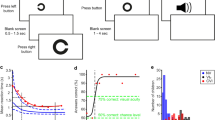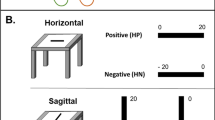Abstract
The cause of developmental dyscalculia, a specific deficit in acquisition of arithmetic skills, particularly of enumeration, has never been investigated with respect to the patency of the visual magnocellular system. Here, the question of dysfunction of the afferent magnocellular cortical input and its dorsal stream projections was tested directly using nonlinear analysis of the visual evoked potential (VEP) and through the psychophysical ability to rapidly detect visual change. A group of young adults with self-reported deficiencies of arithmetical ability, showed marked impairment in magnitude estimation and enumeration performance—though not in lexical decision reaction times when compared with an arithmetically capable group controlled for age and handedness. Multifocal nonlinear VEPs were recorded at low (24 %) and high (96 %) contrast. First- and second-order VEP kernels were comparable between groups at low contrast, but not at high contrast. The mathematically impaired group showed an abnormal lack of contrast saturation in the shortest latency first-order peak (N60) and a delayed P100 positivity in the first slice of the second-order kernel. Both features have previously been argued to be physiological markers of magnocellular function. Mathematically impaired participants also performed worse on a gap paradigm change detection for digit task showing increased reaction times for high-contrast stimuli but not for low-contrast stimuli compared with controls. The VEP results give direct evidence of abnormality in the occipital processing of magnocellular information in those with mathematical impairment. The anomalous high visual contrast physiological and psychophysical performance suggests an abnormality in the inhibitory processes that normally result in saturation of contrast gain in the magnocellular system.




Similar content being viewed by others
References
Ansari D, Lyons IM, van Eimeren L, Xu F (2007) Linking visual attention and number processing in the brain: the role of the temporo-parietal junction in small and large symbolic and nonsymbolic number comparison. J Cogn Neurosci 19:1845–1853. doi:10.1162/jocn.2007.19.11.1845
Anton-Erxleben K, Stephan VM, Treue S (2009) Attention reshapes center-surround receptive field structure in macaque cortical area MT. Cereb Cortex 19:2466–2478. doi:10.1093/cercor/bhp002
Baron-Cohen S, Wheelwright S, Skinner R, Martin J, Clubley E (2001) The autism-spectrum quotient (AQ): evidence from Asperger syndrome/high-functioning autism, males and females, scientists and mathematicians. J Autism Dev Disord 31:5–17
Baseler HA, Sutter EE (1997) M and P components of the VEP and their visual field distribution. Vision Res 37:675–690
Beck DM, Rees G, Frith CD, Lavie N (2001) Neural correlates of change detection and change blindness. Nat Neurosci 4:645–650. doi:10.1038/88477
Ben-Shachar M, Dougherty RF, Deutsch GK, Wandell BA (2007) Contrast responsivity in MT + correlates with phonological awareness and reading measures in children. Neuroimage 37:1396–1406. doi:10.1016/j.neuroimage.2007.05.060
Bullier J (2001) Integrated model of visual processing. Brain Res Rev 36:96–107
Burr DC, Turi M, Anobile G (2010) Subitizing but not estimation of numerosity requires attentional resources. J Vis 10:20. doi:10.1167/10.6.20
Cai L (2006) Multi-response permutation procedure as an alternative to the analysis of variance: an SPSS implementation. Behav Res Methods 38:51–59
Carandini M, Heeger DJ, Senn W (2002) A synaptic explanation of suppression in visual cortex. J Neurosci 22:10053–10065
Culham JC, Brandt SA, Cavanagh P, Kanwisher NG, Dale AM, Tootell RB (1998) Cortical fMRI activation produced by attentive tracking of moving targets. J Neurophysiol 80:2657–2670
Dakin S, Bex P (2001) Local and global visual grouping: tuning for spatial frequency and contrast. J Vis 1:99–111. doi:10.1167/1.2.4
Dehaene S, Bossini S, Giraux P (1993) The mental representation of parity and number magnitude. J Exp Psychol Gen 122:371–396
Dehaene S, Piazza M, Pinel P, Cohen L (2003) Three parietal circuits for number processing. Cognit Neuropsychol 20:487–506
Demb J, Boynton G, Heeger D (1998) Functional magnetic resonance imaging of early visual pathways in dyslexia. J Neurosci 18:6939–6951
Eden G, VanMeter J, Rumsey J, Maisog J, Woods R, Zeffiro T (1996) Abnormal processing of visual motion in dyslexia revealed by functional brain imaging. Nature 382:66–69
Forrest B (2004) The utility of math difficulties, internalized psychopathology, and visual-spatial deficits to identify children with the nonverbal learning disability syndrome: evidence for a visualspatial disability. Child Neuropsychol 10:129–146
Foss-Feig JH, Tadin D, Schauder KB, Cascio CJ (2013) A substantial and unexpected enhancement of motion perception in autism. J Neurosci 33:8243–8249. doi:10.1523/JNEUROSCI.1608-12.2013
Jackson BL et al (2013) Magno- and parvocellular contrast responses in varying degrees of autistic trait. PLoS ONE 8:e66797. doi:10.1371/journal.pone.0066797
Kapadia MK, Westheimer G, Gilbert CD (2000) Spatial distribution of contextual interactions in primary visual cortex and in visual perception. J Neurophysiol 84:2048–2062
Kaplan E, Lee BB, Shapley RM (1990) New views of primate retinal function. In: Osborne N, Chader G (eds) Progress in retinal research. Pergamon Press, Oxford, pp 273–336
Klistorner A, Crewther DP, Crewther SG (1997) Separate magnocellular and parvocellular contributions from temporal analysis of the multifocal VEP. Vision Res 37:2161–2169
Lamme VA, Roelfsema PR (2000) The distinct modes of vision offered by feedforward and recurrent processing. Trends Neurosci 23:571–579
Laycock R, Crewther S, Crewther D (2007) A role for the ‘magnocellular advantage’ in visual impairments in neurodevelopmental and psychiatric disorders. Neurosci Biobehav Rev 31:363–376. doi:10.1016/j.neubiorev.2006.10.003
Laycock R, Crewther DP, Crewther SG (2012) Abrupt and ramped flicker-defined form shows evidence for a large magnocellular impairment in dyslexia. Neuropsychologia 50:2107–2113. doi:10.1016/j.neuropsychologia.2012.05.012
Nieder A (2005) Counting on neurons: the neurobiology of numerical competence. Nat Rev Neurosci 6:177–190
Osmon DC, Smerz JM, Braun MM, Plambeck E (2006) Processing abilities associated with math skills in adult learning disability. J Clin Exp Neuropsychol 28:84–95. doi:10.1080/13803390490918129
Piazza M et al (2010) Developmental trajectory of number acuity reveals a severe impairment in developmental dyscalculia. Cognition 116:33–41. doi:10.1016/j.cognition.2010.03.012
Price GR, Ansari D (2013) Developmental dyscalculia. Handb Clin Neurol 111:241–244. doi:10.1016/B978-0-444-52891-9.00025-7
Raven J (2003) Raven’s advanced progressive matrices (APM). Pearson, Sydney
Rensink RA (2000) Seeing, sensing, and scrutinizing. Vision Res 40:1469–1487
Rensink RA (2002) Change detection. Annu Rev Psychol 53:245–277. doi:10.1146/annurev.psych.53.100901.13512553/1/245
Rutkowski J, Crewther D, Crewther S (2003) Change detection is impaired in children with dyslexia. J Vis 3:95–105
Schwartz S, Vuilleumier P, Hutton C, Maravita A, Dolan RJ, Driver J (2005) Attentional load and sensory competition in human vision: modulation of fMRI responses by load at fixation during task-irrelevant stimulation in the peripheral visual field. Cereb Cortex 15:770–786. doi:10.1093/cercor/bhh178
Sutherland A, Crewther DP (2010) Magnocellular visual evoked potential delay with high autism spectrum quotient yields a neural mechanism for altered perception. Brain 133:2089–2097. doi:10.1093/brain/awq122
Sutter E (2000) The interpretation of multifocal binary kernels. Doc Ophthalmol 100:49–75
Tadin D, Lappin JS, Gilroy LA, Blake R (2003) Perceptual consequences of centre-surround antagonism in visual motion processing. Nature 424:312–315. doi:10.1038/nature01800
Tadin D, Kim J, Doop ML, Gibson C, Lappin JS, Blake R, Park S (2006) Weakened center-surround interactions in visual motion processing in schizophrenia. J Neurosci 26:11403–11412. doi:10.1523/jneurosci.2592-06.2006
Trick LM, Pylyshyn ZW (1994) Why are small and large numbers enumerated differently? A limited-capacity preattentive stage in vision. Psychol Rev 101:80–102
Uhlhaas PJ, Singer W (2010) Abnormal neural oscillations and synchrony in schizophrenia. Nat Rev Neurosci 11:100–113. doi:10.1038/nrn2774
Yoon JH, Maddock RJ, Rokem A, Silver MA, Minzenberg MJ, Ragland JD, Carter CS (2010) GABA concentration is reduced in visual cortex in schizophrenia and correlates with orientation-specific surround suppression. J Neurosci 30:3777–3781. doi:10.1523/JNEUROSCI.6158-09.2010
Zorzi M, Priftis K, Umilta C (2002) Brain damage: neglect disrupts the mental number line. Nature 417:138–139
Acknowledgments
The authors would like to kindly thank Gemma Lamp for her assistance in the recruiting of mathematically impaired participants and Laila Hugrass for her assistance with data preparation. The study was supported in part by the NHMRC, Australia.
Author information
Authors and Affiliations
Corresponding author
Rights and permissions
About this article
Cite this article
Jastrzebski, N.R., Crewther, S.G. & Crewther, D.P. Mathematical impairment associated with high-contrast abnormalities in change detection and magnocellular visual evoked response. Exp Brain Res 233, 3039–3046 (2015). https://doi.org/10.1007/s00221-015-4373-y
Received:
Accepted:
Published:
Issue Date:
DOI: https://doi.org/10.1007/s00221-015-4373-y




